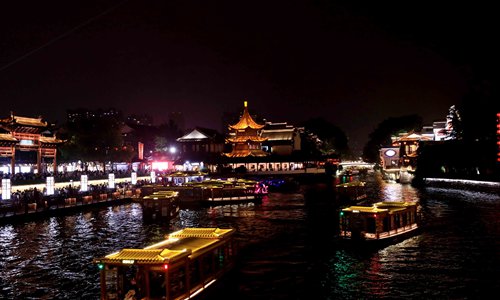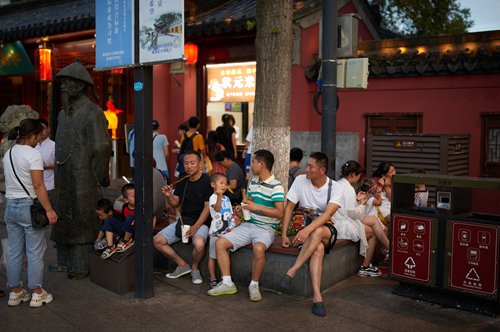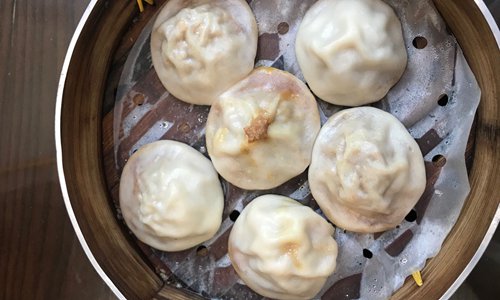HOME >> LIFE
Sway with the taste of Chinese history
By Bi Mengying in Nanjing Source:Global Times Published: 2019/8/19 18:23:39

The night view of the Qinhuai River in Nanjing Photo: IC

Visitors at the Confucius Temple Photo: IC

Tangbao Photo: Bi Mengying/GT
Nanjing, capital of East China's Jiangsu Province, is an ancient capital of six Chinese dynasties dating back to AD220. While the city has been playing a key role in Chinese history, the food in Nanjing is also home to a rich and diverse Chinese cuisine.
I traveled to Nanjing alone, without anybody to share a large meal with. So, I decided to find companionship in Nanjing's street food.
The city of ducks
Ubiquitously seen in Chinatowns across the world, Peking duck might be considered a famous Chinese dish to people from other countries. Yet Nanjing is actually the city known as yadu (meaning the city of ducks in Chinese) in China.
There is a popular saying among Nanjing residents: No duck can leave Nanjing alive. Almost every part of a duck can be cooked and the waterfowl is a delicacy among Nanjing residents. Yanshui ya (salted duck), lu yashe (duck tongue cooked in a Chinese stew), chao yaxin (stir-fried duck heart), and jiang yatou (stewed duck head), are just a few to mention. While these dishes may be uniquely consumed in Nanjing, yaxue fensitang (duck blood and vermicelli soup), which is another local delicacy of Nanjing, is well-received by people across China with great enthusiasm.
Duck blood and vermicelli soup
Yaxue fensitang can be easily acquired in other cities in China, and it is even listed as one single category among the 20-or-so categories on Meituan, a widely used food delivery app in China. However, you have to go to Nanjing for its authentic taste.
I did some basic research on dazhongdianping, which is similar to a Chinese version of Yelp or TripAdvisor, a restaurant reviewing website. There was a list for all the yaxue fensitang in Nanjing. Ranking first was Xiaopanji Yaxue fensitang. With over 3,600 reviews, it scored 4.5 stars out of 5. Since my stay in Nanjing was fairly short, less than two days, but added up to six meals, I could not forgive myself for not eating the best street food that I could get. So, I contacted my friend surnamed Deng, who grew up in Nanjing.
"My favorite yaxue fensitang place throughout my childhood used to be a restaurant chain called Huiwei (meaning aftertaste in Chinese). As the store expanded, the flavor and childhood memories kind of faded. Xiaopanji has become popular in recent years. It is very tasty," she said. After obtaining approval from my trustworthy friend, I set off for Xiaopanji.
The subway system is well-developed in Nanjing and can easily get you everywhere in the city. Around lunchtime, I took Line 3 and got off at Fuqiao Station. After a few minutes of walking, the crowd could be seen from afar. There was no line. You just order at the counter and try your luck to snatch a seat. I was led to an "outdoor seating" area composed of relatively tall and short stools. One was used as a table.
I treated myself with the luxurious Xiaopanji Tese (meaning specialty in Chinese) yaxue fensitang, which was 28 yuan (about $4), a bit more expensive than the regular one priced at 15 yuan, which was a decision that I did not regret.
The ingredients in it were so diverse - vegetables, crunchy rice, duck blood, dried fried tofu, soy sauce egg, duck gizzards, duck intestines, and duck livers. The soup was tasty as well with a touch of ginger and sesame oil.
Two girls sitting next to me told me they traveled to Nanjing from Wuhan in Hubei Province. They also found the place on dazhongdianping. The crowd was not made up of travelers. Some of them were college students who were leaving home for summer vacation, and some worked at the offices nearby.
Overall, this is a place that I'd definitely return to, but I'd probably avoid lunch hours the next time.
'Tangbao' and taro dessert
For dinner, I had my eyes set on tangbao (soup-filled steamed buns). Based on online reviews and for the purpose of traveling to nearby tourist spots, I chose Jiming Tangbao on Jinshajing Street.
You can order a set of tangbao which contains eight pieces. Trust me, it's never too much. The skin of the tangbao was so thin, yet none of the buns were broken. The buns' insides are filled with meat and chicken soup. After a single bite, the soup and the filling melts in your mouth. The taste was ineffable.
After eight pieces of tangbao sitting in my stomach, I ordered guihua tang yumiao, a traditional dessert in Nanjing consisting of stewed taro with sweet osmanthus syrup. The sweet-to-the-right-extent taste of the dessert complemented the aftertaste of the juicy tangbao. In traditional Chinese medicine, taro is considered nutritious, good for the immune system, and suitable for almost everyone.
Moreover, legend has it that the round shape of the sliced taro in the dessert symbolizes people's good wishes towards the fullness of life and the gathering with families.
Following the pleasant meal, I took a leisurely stroll around the Confucius Temple, which was right next to Jiming Tangbao. I concluded my trip with contentment and peace by watching the boats sway on the Qinhuai River, which is a scene that has frequently appeared in ancient Chinese literature and poetry.
Newspaper headline: Nanjing’s street eats
Posted in: FOOD,MISCELLANY